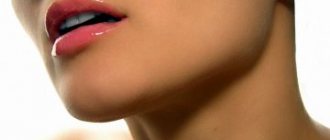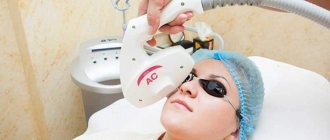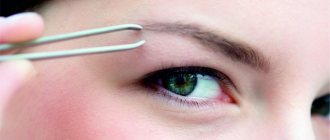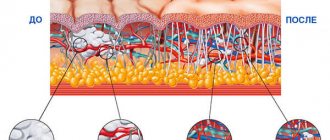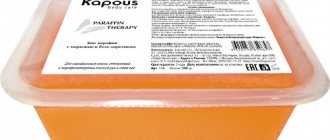A popular method of hair removal today is photoepilation; its contraindications and consequences are discussed, but its effectiveness has been proven repeatedly. This is a method of hair removal using high pulse light and is not recommended for certain diseases and conditions. Negative and side effects are possible due to the fault of unscrupulous cosmetologists and for other reasons.
The essence of the method
Photoepilation is not ordinary hair removal, which affects excess hair with dozens of small tweezers that instantly grab and very painfully pull out the hair. Photoepilation acts gradually and gently, without injuring the skin or compromising the integrity of the epidermis.
The essence of the method is that the hair shaft is briefly exposed to a high-power light flux. Light energy turns into heat, the hair heats up to a temperature of plus 80 degrees Celsius, and the follicle dies. After some time it falls out, new hair in this place will not grow for a long time. Therefore, photoepilation is a procedure that will rid you of unwanted hair not for a week or a month, but for a couple of years. The main thing is to complete the full course, and not limit yourself to one procedure, despite its high cost. The price of photoepilation depends on the number of flashes; accordingly, the most expensive thing to do is the legs and arms, the cheapest is the bikini area, armpits and face.
Types of photoepilation:
- IPL. The name is similar to laser hair removal, but the length of the rays is different (600-900 nanometers), therefore, it is photoepilation. The most effective, but traumatic type, since the flash lamp affects the hair follicles with high-intensity flashes. IPL hair removal is used to remove all types of hair, except red, blond and gray hair.
- Elos. Removes even the most fragile, light hair, which almost does not absorb light energy. This type is the safest, the skin is protected from overheating, so the risk of burns and irritation is minimal.
- LHE hair removal. This type is the most painful; no cooling gels are used in the process, but only LHE rays can deal with coarse and gray hairs. The procedure covers the largest area of the treated surface at a time - up to 11 square meters. cm.
Only a master will be able to tell which type of photoepilation is most appropriate in your case.
Laser or photoepilation, which is better?
The main advantage of photoepilation compared to laser hair removal is its versatility. Thanks to the wide wavelength range (600-950 nm for the Ellipse Multi Flex HR system applicator), it is possible to remove unwanted hair of any structure (hard, soft, vellus) and almost any color, with the exception of gray hair. The high speed of photoepilation is also an undeniable advantage compared to laser hair removal. The laser has a small coverage area, only 1.5 cm2, which significantly increases the duration of the procedure. The working surface area of the HR applicator is 4.8 cm2, and the HR+ applicator is 8.6 cm2, which makes the photoepilation procedure on the Ellipse Multi Flex device fast even over large areas, for example, when photoepilating the lower legs or thighs. Due to the high light density, laser hair removal is painful and cannot be performed without cooling the skin. During photoepilation, the hair follicle heats up instantly, and the procedure is easily tolerated; anesthesia and cooling are not required.
What hair length is optimal for photoepilation?
For photoepilation, the optimal hair length is 1 mm. This is quite enough for light energy to selectively affect the melanin pigment contained in the hair, which absorbs light and converts it into heat. The heat, in turn, penetrates the hair follicle, which heats up and is destroyed. With longer hair, some of the energy dissipates while it reaches the hair follicle, which leads to a decrease in the intensity of the effect. Thus, 1-2 days before the procedure, you need to shave your hair or use a trimmer. Remember that there should be no cuts or abrasions in the treated area.
Will your hair fall out immediately after the procedure?
No, not right away. Hair will fall out after the procedure within 7-10 days. This is due to the fact that during this time the vascular network feeding the hair follicle is destroyed, and the hair dies after the procedure. Sometimes this process takes more than 10 days.
Is bikini photoepilation contraindicated in the first days of the menstrual cycle?
No, this is not a contraindication. But we must remember that these days there is increased sensitivity.
Is photoepilation performed in areas of natural hyperpigmentation, for example, in the deep bikini area?
The Ellipse Multi Flex system allows photoepilation on any part of the body, even in areas of natural hyperpigmentation. Expert mode allows the doctor to set the intensity and power of light radiation based on specified parameters, which makes the procedure in such areas safe and effective.
Is it possible to do photoepilation in the summer?
Yes, you can. When performing the procedure in the summer, you must use sunscreen on exposed parts of the body. After returning from active sun, you must wait 2-3 weeks, since it is strictly forbidden to carry out the procedure on tanned skin.
Today I had bikini photoepilation, after what time should I repeat the procedure?
The interval between bikini photoepilation procedures is 4-6 weeks. Hair experiences periods of rest and growth. Hair follicles are destroyed by broadband pulsed light only in the phase of active hair growth (anagen). About 25-30% of hair is in this phase. The average number is 4-6 procedures and depends on the hair color and thickness, the amount of hair in the growth stage, skin type, and the depth of the hair follicle.
Is it possible to perform a deep bikini photoepilation procedure if there is a tendency to form keloid scars?
It is not recommended to carry out photoepilation of a deep bikini if you are prone to the formation of keloid scars.
Is the skin damaged during the photoepilation procedure?
No, it is not damaged. The procedure for removing unwanted hair occurs without compromising the integrity of the skin. Any photoepilation procedure begins after preliminary testing in the exact place where hair removal is planned. Properly selected parameters reduce the risk of negative consequences to zero.
What should you not do after photoepilation?
After the procedure, you should not sunbathe or go to the solarium for two weeks. When performing the procedure on exposed parts of the body, use a product with SPF. For three days you cannot visit the bathhouse, sauna, swimming pool and limit water treatments as much as possible.
After the photoepilation procedure, redness occurred, is this normal?
Yes, this is a normal skin reaction after the procedure. You need to know that the thicker and blacker the hair, the more pronounced the perifollicular swelling and redness of the skin will be. This is not a complication of the procedure, but a necessary step towards the desired result. After the procedure, “Panthenol” or “Bepanten” is applied; they can also be used at home.
Is it possible to do photoepilation of hair that grows from a nevus?
No, you cannot, as thermal damage to the nevus cells may occur.
At what age can photoepilation be done?
Photoepilation can be done after hormonal levels have normalized, usually after 16-17 years.
Is it possible to do photoepilation during pregnancy?
No you can not. Changed hormonal levels provoke the development of hyperpigmentation, plus increased sensitivity to pain during pregnancy contributes to the production of stress hormones, which is extremely undesirable for a woman during this period.
Is it possible to remove hair with wax between photoepilation sessions?
No you can not. It is prohibited to pluck or pull out hair during the course of photoepilation, or to use wax, sugar and other types of hair removal associated with trauma to the hair follicle. Only shaving is allowed.
How many flashes will be required for photoepilation in the lower leg area?
It is difficult to say the exact number of outbreaks. Since the working surface area of the applicator measures 10x48 mm or 18x48 mm, a fairly large amount of hair can be exposed to one flash of light. Based on this, you can calculate the required number of flashes.
How long does the photoepilation procedure take?
It all depends on the area of the treated area. Photoepilation of the area above the upper lip will take approximately 5 minutes, the back, arms or legs - from 1 to 1.5 hours.
How painful is the procedure for deep bikini photoepilation? Is anesthesia required?
No anesthesia is required. Everyone's pain threshold is different, but in general the procedure is well tolerated. Most patients compare their sensations to the click of a rubber band on the skin.
Is photoepilation effective for men?
Yes, it is effective. The photoepilation method provides men with additional opportunities in shaping their image. Men often do photoepilation in the back and chest, in the face and neck; this procedure is especially relevant for constant irritation after shaving in the neck area.
Can I do a few test flashes to see how my skin reacts? How much will it cost?
Testing is carried out before the photoepilation procedure in accordance with established rules and evaluation criteria. The choice of procedure parameters depends on hair thickness, skin color, treatment area, etc. Consultation with a cosmetologist and testing are carried out in our center free of charge.
Is it possible to correct axillary hyperhidrosis and photoepilate this area in one procedure?
Treatment of hyperhidrosis of the armpits and photoepilation of this area is not carried out on the same day. It is necessary to observe the interval between these procedures.
When to choose photoepilation
Who, first of all, should pay attention to this type of unwanted hair removal, such as photoepilation? These are people suffering from hirsutism. If there is too much unwanted hair on the body, especially on a woman, it is often coarse, very dark and grows quickly. Everyday, non-salon forms of hair removal, for example, shaving or regular hair removal, help in this case for a short time. Frequent shaving or removing unwanted hair with an epilator can cause irritation and provoke the problem of ingrown hairs. And not everyone has enough time to simply focus on the problem of smooth skin every other day. Salon treatments come to the rescue. Photoepilation allows you to forget about the problem of excess hair for a long time.
Photoepilation - consequences
Any cosmetic procedure has complications. Characteristic negative consequences of photoepilation are the appearance of scars and changes in skin pigmentation.
What could be:
- If exposure to light causes deep burns that are not treated properly, or the skin becomes infected, scarring occurs.
- After a burn, spots of a lighter shade may appear on the epidermis. The phenomenon is called hypopigmentation.
- When a person takes photosensitizing drugs during the procedure, skin hyperpigmentation is possible. Such drugs include tetracycline antibiotics and certain cosmetics with citrus and bergamot essential oils.
Photoepilation - health consequences
The photoepilation procedure is not dangerous for human health if it is carried out correctly and all contraindications are taken into account.
Serious consequences are possible in a number of cases, and specialists always pay attention to them before carrying out the procedure:
- Treating the skin in areas where nevi accumulate can lead to cancer. Especially if the hair grows from a mole, you should not touch it.
- When manipulation is carried out on the face (removing mustaches or too full eyebrows) without observing safety precautions, burns and eye damage occur.
- Consequences on skin prone to allergies - rashes and itching after photoepilation. Treated with antihistamines.
Contraindications
Who will benefit from photoepilation:
- people with infectious diseases in the acute stage;
- herpes virus, including Epstein-Bar virus and cytomegalovirus;
- varicose veins;
- wounds and scars on the area of skin that will be treated:
- any serious chronic diseases in the acute stage;
- with photosensitivity.
If you decide to have photoepilation, first consult a dermatologist. Do you suffer from hirsutism? Find out whether the cause of this phenomenon is a serious hormonal imbalance, otherwise you will simply waste your money - new hairs will begin to appear earlier than six months after the course of procedures.
Indications and contraindications
The photoepilation procedure is suitable for those who value their time. The session lasts, on average, 20-30 minutes. Photoepilation is considered very effective, since within a few days after the procedure you can lose about forty percent of your hair. After just six sessions, all hair follicles die off, and the result is perfectly smooth skin. The undeniable advantage of this procedure is that, along with the removal of unnecessary hair, a special protein is synthesized in the skin - collagen, thanks to which the skin is evened out, becomes more elastic, and acquires a healthy color.
Photoepilation is suitable for those who have coarse dark hair growing on their body, which, after regular shaving, begins to grow the very next day with greater force. The procedure is also recommended for those with sensitive skin prone to irritation.
Like any cosmetic procedure, photoepilation has contraindications. These include the presence of tumors, both benign and malignant. This procedure should not be performed for people with heart disease, diabetes, epilepsy, or poor blood clotting. Those with problems with the thyroid gland and varicose veins should also refrain from photoepilation.
Beauty HACK ✔ CONSEQUENCES and CONTRAINDICATIONS Photoepilator PHILIPS LUMEA PRESTIGE
Photoepilation procedure
The procedure goes as follows:
- After a detailed consultation, determining the type of photoepilation and calculating the cost, you are laid on a couch and the corresponding part of the body is exposed, which will be deprived of unwanted hair. If a “deep bikini” is made, then the couch is replaced by a chair similar to a gynecological one.
- The procedure is delicate; if the hairs are too long, they will begin to melt. Therefore, before going for photoepilation, it is advisable to shave, or the master himself can shave you before the procedure.
- A cooling gel is applied to the skin, the device is turned on, and the specialist uses flashes to remove hairs.
- The duration of the procedure depends on the area being treated: a “deep bikini” takes half an hour, legs – about two.
- After the procedure, the cooling gel is wiped off, and anti-burn cream or gel is applied to the skin.
- After some time, in the place where the follicles were destroyed with the help of photo rays, a small growth of unwanted hairs will still begin. The master advises in this case to shave, this contributes to the active destructuring of the hairs.
- The course consists of several procedures with a break of two to three weeks.
The video describes all the details of photoepilation performed in a beauty salon and analyzes the pros and cons of the procedure.
LiveInternetLiveInternet
Skin care after photoepilation
Photoepilation appeared in beauty salons relatively recently. However, this effective painless method of getting rid of hair is preferred by many girls and women, despite the high price. Although it's not that high, if you think about it. Let's consider some details of the method, noting its effectiveness, which is manifested in the irreversible destruction of the hair follicle. This is done in the salon using a lamp specially designed for this purpose. Every woman who has decided on this procedure, deciding to get rid of unwanted body hair forever, can confirm that photoepilation is effective.
How is the hair follicle destroyed? Thanks to the broadband light of the lamp, which is absorbed by the melanin pigment, a gradual destructive effect occurs. After the first procedure, you can observe a reduction in the amount of hair by about 30%. And those hairs that remain become thin and, accordingly, almost invisible. Thanks to photoepilation, you can achieve amazing results, making your legs and other areas of the body smooth as silk!
The photoepilation method is considered painless , since patients only feel a slight tingling sensation. In order to minimize tingling and discomfort during the procedure, it is recommended to use a special cooling gel.
Skin care after photoepilation consists of several stages. By following the recommendations and tips below, you will protect your body from possible complications. Read carefully.
- After the session, lubricate your skin with sunscreen. In this case, the degree of protection must be at least SPF30. The cream should be applied regularly for 2 weeks.
- Drink plenty of fluids. Increase its consumption in your diet. The skin should receive a full amount of moisture. It is important.
- During the day of the session, you should not take a hot shower or go to the steam room. It's better to take a cool shower.
- It is not recommended to wear clothes made of rough fabric, which can damage the skin.
- Try to touch the skin gently. Do not comb or rub it intensively. Massage is also contraindicated.
- It is better to stop using whitening creams and perfumed products for a while. We act on the principle: as little chemicals as possible on the skin.
- Avoid sunbathing, depilation with wax or cream. Treat the area of skin that has undergone photoepilation with special means, for example, the drug “Panthenol”.
- The cosmetic products you usually use should not contain alcohol. They must be hypoallergenic.
- Avoid the sun. The skin should not be exposed to direct rays of the sun.
Photoepilation devices
Photoepilation devices began to appear more than 10 years ago. They produce powerful pulsed light in the range of 500-1200 nm, including unsafe ultraviolet light, but in order to avoid negative effects, special filters are built into the devices. The highest quality and popular salon brands include Skin Station Mistral (a multifunctional device used for photoepilation, skin rejuvenation and treatment of various dermatological diseases), Ellipse Light, Record 618, Classic 512, Quantum HR/SR, Apollo V+ with a built-in computer.
Home photoepilators include devices from the brands Philips Lumea, E-Flash, E-one Clinic R, HPLight, E-ONE Evolution. Home photoepilation has its pros and cons:
- you don’t need to pay large sums in beauty salons or waste time visiting a specialist;
- portable photoepilators are characterized by low power and the ability to maneuver, so the effect of non-salon equipment leaves much to be desired;
- In the wrong hands, the device can cause burns.
Skin care after photoepilation
Immediately after light hair removal, the skin looks healthy, but requires special care. The epidermis has been exposed to heat, so redness and slight itching are normal.
Whether photoepilation was carried out at home or in a salon, to consolidate the result and reduce the impact of negative factors, it is recommended to do the following:
- Limit water treatments (hot baths, saunas) and sunbathing.
- In the first 2-3 days, do not use cosmetics containing alcohol and chemical components (only natural ingredients), fatty oils that form a film on the skin.
- Soothe the treated areas with panthenol cream or chamomile or aloe juice.
- To replenish the water balance in the body, drink more water.
When photoepilation is performed, contraindications and consequences must be taken into account so as not to expose yourself to negative factors and side effects. If the procedure is carried out independently, without visiting a cosmetologist, taking precautions before, during and after skin treatment will help reduce the risk.
Possible complications
If you ignore the specialist’s recommendations during the preparatory period, the procedure can lead to the following undesirable consequences:
- Tissue burns with further skin pigmentation.
- Folliculitis (inflammation of the bulb).
- Swelling of tissues that does not go away within several days.
- Allergic reaction.
- The appearance of age spots.
If a woman feels severe discomfort during the procedure, the specialist should be notified immediately, as painful sensations may be a symptom of a burn.
How is a photoepilation session carried out?
The procedure will take very little time - approximately 15 minutes to treat one area. Photoepilation is carried out as follows:
- A special conductive gel is applied to the area of the body that will be treated, protecting the epidermis from burns.
- Not only the client, but also the master puts on protective glasses that protect the retina from the negative effects of photo flashes.
- A special device is applied to the skin and an impulse is performed.
- The tip of the device is very narrow, so only a few square centimeters are processed at a time.
- If hair is removed from the armpit or bikini area, you may experience mild pain such as a tingling or burning sensation. To minimize discomfort, a short pause is made between flashes.
- The stream of light destroys the hair follicles and the damaged hairs fall out over the next few weeks.
- To obtain perfectly smooth skin, you need to complete a full course of photoepilation, consisting of 8–10 sessions. There is a break of 30–60 days between each procedure.
Caution: photoepilation!
The popularity of photoepilation has made this technology available not only in specialized salons, but also at home - compact lamps are available for sale for self-hair removal using the photo method. Despite all the conveniences of this approach, it significantly increases the risks of complications and harm to the body. Photoepilation has quite a lot of contraindications that you can ignore due to ignorance and inexperience, and such amateur activity can become very dangerous indeed.
Be especially careful when using photoepilator at home
Contraindications
A highly qualified master is obliged not only to pay close attention to each client, but also to refuse the procedure if at least one of the following factors is present:
- pregnancy and lactation;
- allergies and dermatoses;
- ringworm and eczema;
- oncology;
- high pressure;
- ischemic disease;
- diabetes;
- varicose veins;
- tattoos;
- fresh tan;
- wounds, abrasions or scratches;
- a large number of birthmarks, moles, warts or papillomas in the work area.
Avoid photoepilation on areas of the skin where tattoos are made.
There are other, equally important contraindications that a specialist should take into account when performing photoepilation:
- herpes;
- psoriasis and vitiligo;
- worms;
- endocrine diseases;
- mental disorders;
- heat;
- period;
- acute phases of any chronic diseases;
- predisposition of the skin to the formation of scars.
An experienced specialist must consider all options for contraindications.
In such cases, the cosmetologist also has the right to refuse to work with the client or recommend a course of preliminary consultations with the attending physician and appropriate treatment of the underlying disease.
Possible consequences
Violations of the rules for preparing and conducting photoepilation, as well as insufficient skin care after completion of the procedure, can lead to unpleasant consequences. An experienced specialist will tell you about them in a timely manner and discuss with the client in advance how to avoid side effects:
- Proper use of painkillers and cooling agents both before and after the procedure will help protect against pain;
- swelling, itching and redness that are inevitable with sensitive skin usually quickly go away on their own, but sometimes also require the use of medicinal drugs;
- burns are the most common consequence of improper photoepilation - they should be treated immediately and seriously;
- scars are highly likely to appear on the skin after burns and infection - getting rid of scars will not be easy;
- pustular inflammation of the hair follicles (folliculitis) most often manifests itself when the rules for caring for the dermis after the procedure are violated;
- pigmentation - small areas of the skin can either darken or lighten, such effects can either go away on their own or remain forever;
- vision problems - during photoepilation, the eyes must be protected with special dark glasses; failure to comply with this rule leads to serious consequences, the most “harmless” of which is a decrease in visual acuity.
Both the client and the doctor should protect their eyes with special glasses
Mistakes, irresponsibility or low qualifications of a cosmetologist can lead to more dangerous consequences for health - for example, to malignant degeneration of tissue at the site of moles or birthmarks.
Large moles are a contraindication for photoepilation
Sometimes, if the photoepilator mode is not chosen accurately, a paradoxical effect such as hypertrichosis can occur - instead of falling out, the hair significantly increases its growth.
Video: some aspects and unpleasant consequences of photoepilation
Effect on pregnancy
Although most experts claim that photoepilation affects only superficial tissues, without in any way affecting internal organs, much less affecting the development of the fetus, this fact has not yet been fully confirmed.
Pregnancy is not the best time for photoepilation
Even minimal risks to the health of the expectant mother and baby make the procedure unacceptable during the period of pregnancy. Moreover, photoepilation is by no means as painless as advertising makes it out to be; and any pain syndrome can tone the uterus, thereby provoking unpredictable consequences for the embryo - even spontaneous abortion.
Please also take into account the fact that during pregnancy and breastfeeding, a woman’s hormonal levels change significantly, and this may well affect the results of the procedure. During these critical periods, it is better to postpone photoepilation, replacing it with safer methods of hair removal.
In addition to photoepilation, there are other ways to achieve smooth, velvety skin.
Cost of salon procedure
The price for photoepilation services, as well as for laser hair removal, depends on many factors. The specialist must select the required number of sessions, determining the amount of work in advance. Naturally, prices for services in prestigious salons are much higher than photoepilation in less popular places.
Before signing up for a procedure, it is advisable to study the market for offering this service. If you choose the most expensive salon located in the city center, there is no guarantee that photoepilation will be performed perfectly there. Perhaps in a small beauty salon, which is located in one of the residential areas, the procedure will be done no worse, but at lower prices.
It is worth finding out what kind of reviews the photoepilation leaves, and who has already visited this or that place. Perhaps one of your acquaintances and friends will recommend a specific master who should be contacted.
Photoepilation procedure in the salon
On average, prices in salons are as follows:
- deep bikini – 800-1500 rubles;
- armpits – 900-1500 rubles;
- drumsticks – 3500-4300 rubles;
- face – starting from 350 rubles.
Contraindications for photoepilation
Photoepilation, like any other modern cosmetic procedure, has certain contraindications that you need to familiarize yourself with before it is performed:
- pregnancy period;
- lactation;
- high blood pressure;
- oncological diseases;
- epilepsy;
- varicose veins;
- various cardiovascular diseases;
- age under 16 years;
- skin diseases (for example, psoriasis, herpes, etc.);
- tendency to form keloid scars;
- viral diseases;
- exacerbation of chronic diseases;
- increased body temperature;
- inflammatory processes and open wounds in the area to be treated.
How to prolong the effect of photoepilation?
After several visits to the salon to remove body hair with a photoepilator, you cannot hope that the effect will last forever. To prolong the positive result, it is recommended to visit a specialist once a year and conduct preventive sessions.
The result also depends on the skill of the cosmetologist, so for photoepilation you need to choose a trusted salon and a professional specialist.
Principle of the technique
This hair removal technique is based on the ability of melanin to absorb light rays. Powerful outbreaks lead to a rapid increase in temperature in the shaft and the hair follicle itself, as a result of which the bulb overheats and dies .
If the procedure is carried out properly, hairs will begin to fall out after just a few days. The advantage of this treatment is that the light flash affects several follicles at once, which significantly reduces the session time.
Before signing up for the procedure, it is recommended to consult with a specialist about contraindications. The cosmetologist will tell you whether photoepilation can be done in a particular case and how many sessions will be required to achieve ideal smoothness of the skin.
After this, based on the entered data (skin color, hair type), the computer selects the optimal mode that will allow you to achieve the best result. The client must take into account that she will have to visit a cosmetologist every 3-4 weeks for several months. If the course is interrupted in the middle, the effect may not be as pronounced.
How to use a photoepilator?
Despite the general operating principle, each home appliance works differently. In particular, some models expose the skin to radiofrequency irradiation and light pulses. Therefore, before using the photoepilator at home, you must read the attached instructions.
Immediately before each procedure, the device should be cleaned of grease and other contaminants. Using a home photoepilator is quite simple. This type of device makes sounds or otherwise indicates contact with the skin and the completion of treatment of the current area.
When removing hair with a photoepilator, you need to move the device from right to left, placing it horizontally or at an angle of 45 degrees to the surface of the dermis. Photoepilation at home, performed taking into account these rules, will be as effective as possible.
On average, up to 50 flashes are required to remove hair in one area. This must be taken into account in case of breakdown of the key elements of the device. The duration of one session of home photoepilation depends on the area being treated:
- face - 7-10 minutes;
- bikini area - 25-40 minutes;
- legs - 15-25 minutes;
- armpits - 10-15 minutes.
During the session, you should pay attention to the sensations that arise when removing hair. Home photoepilators do not cause pain. If it appears, you need to reconfigure the device to a lower power.
